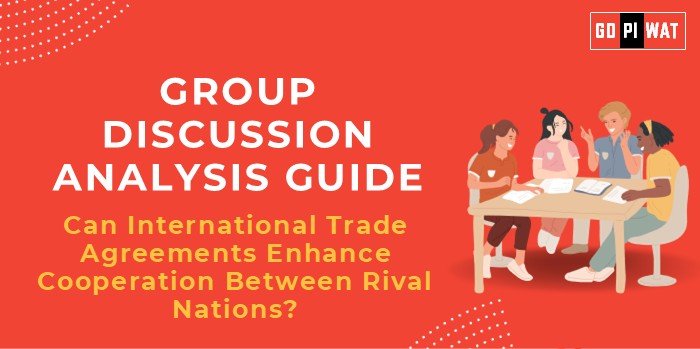📋 Group Discussion (GD) Analysis Guide
🌍 Can International Trade Agreements Enhance Cooperation Between Rival Nations?
💡 Introduction to the Topic
🌱 Opening Context: International trade agreements often serve as a bridge between rival nations, promoting economic interdependence and reducing the likelihood of conflict. The increasing globalization of economies has amplified their role in diplomacy and peacebuilding.
📜 Topic Background: Historically, trade agreements like the European Coal and Steel Community (ECSC) have showcased how economic collaboration can transform adversarial relationships into cooperative ones. Recently, agreements such as the USMCA and the RCEP have highlighted the strategic importance of economic partnerships in a geopolitically complex world.
📊 Quick Facts and Key Statistics
- 📈 Global Trade Volume: $32 trillion in goods and services in 2023, highlighting the scale of interconnected economies (WTO, 2023).
- 🌍 China-USA Trade: Despite tensions, bilateral trade reached $690.6 billion in 2022, underscoring the importance of trade in strained relationships.
- 🌏 RCEP Participation: The world’s largest trade pact, involving 15 countries, represents 30% of global GDP and aims to deepen economic ties in the Asia-Pacific region.
- 🇪🇺 EU and Conflict Reduction: The EU’s economic integration has maintained peace among member states for over seven decades.
🌍 Stakeholders and Their Roles
- 🏛️ Governments: Negotiate terms, set tariffs, and ensure compliance with agreements to foster trust and economic growth.
- 🏢 Businesses: Drive economic activity, create jobs, and build transnational networks that enhance cooperation.
- 🌐 International Organizations (e.g., WTO, UN): Provide platforms for negotiation and dispute resolution.
- 🤝 Civil Societies and NGOs: Advocate for fair practices, sustainable development, and equitable benefits.
🏆 Achievements and Challenges
🌟 Achievements:
- 🇪🇺 EU Example: Economic integration helped convert adversaries (e.g., Germany and France) into allies.
- 🇺🇸 USMCA Success: Replaced NAFTA to modernize trade relations and strengthen North American economies.
- 🌏 ASEAN Free Trade Area (AFTA): Enhanced cooperation and economic growth among Southeast Asian nations.
⚠️ Challenges:
- 📉 Asymmetry in Gains: Rival nations often perceive trade imbalances as strategic disadvantages.
- ⚡ Political Tensions: Trade agreements can be undermined by geopolitical disputes (e.g., US-China tariffs).
- 🔍 Compliance Issues: Enforcement mechanisms in trade agreements are often inadequate.
🌍 Global Comparisons:
- NAFTA/USMCA: Showcases modernization of agreements in politically strained regions.
- 🇨🇳 China-Africa Trade: Highlighting economic growth but raising concerns about dependency.
📜 Case Studies:
Examples like the ECSC and the EU’s success demonstrate how shared economic interests fostered long-term peace and cooperation.
✨ Structured Arguments for Discussion
- 💬 Supporting Stance: “Trade agreements incentivize peace by creating mutual economic dependencies that discourage conflict.”
- ⚖️ Opposing Stance: “Unequal benefits from trade agreements often exacerbate rivalries rather than mitigating them.”
- 🔄 Balanced Perspective: “While trade agreements enhance cooperation, their success depends on equitable terms and strong enforcement mechanisms.”
🎯 Effective Discussion Approaches
📖 Opening Approaches:
- 🌍 “The EU’s success in transforming adversaries into allies exemplifies the potential of trade agreements in reducing tensions.”
- ⚡ “While trade fosters cooperation, the uneven gains from agreements like NAFTA highlight underlying challenges.”
🔄 Counter-Argument Handling:
- 📜 Use historical examples (e.g., EU or ECSC) to rebut claims that economic ties cannot reduce conflicts.
- ⚙️ Present solutions like stronger enforcement mechanisms to address compliance concerns.
📈 Strategic Analysis of Strengths and Weaknesses
- 💪 Strengths: Promotes economic growth and interdependence; provides platforms for dialogue during disputes.
- ⚠️ Weaknesses: Vulnerable to political tensions and protectionism; disparities in benefits can fuel mistrust.
- 💡 Opportunities: Global cooperation in trade can extend to climate action and technology sharing.
- 🚨 Threats: Rising nationalism and anti-globalization sentiments.
📚 Connecting with B-School Applications
- 🌟 Real-World Applications: Projects in international business strategy, conflict resolution, and trade negotiation simulations.
- 💬 Sample Interview Questions:
- “How can trade agreements act as a tool for conflict resolution?”
- “Discuss the role of WTO in fostering global trade cooperation.”
- 📖 Insights for B-School Students: Understand economic diplomacy as a key managerial skill; leverage case studies in trade agreements for strategic management courses.


